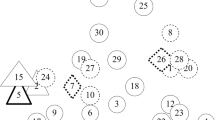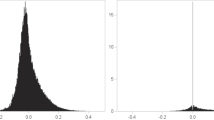Abstract
This paper models the emergence of retail clusters on a supply chain network comprised of suppliers, retailers, and consumers. Firstly, an agent-based model is proposed to investigate retail location distribution in a market of two complementary goods. The methodology controls for supplier locales and unit sales prices of retailers and suppliers, and a consumer’s willingness to patronize a retailer depends on the total travel distance of buying both goods. On a circle comprised of discrete locations, retailers play a non-cooperative game of location choice to maximize individual profits. Our findings suggest that the probability distribution of the number of clusters in equilibrium follows power law and that hierarchical distribution patterns are much more likely to occur than the spread-out ones. In addition, retailers of complementary goods tend to co-locate at supplier locales. Sensitivity tests on the number of retailers are also performed. Secondly, based on the County Business Patterns (CBP) data of Minneapolis-St. Paul from US Census 2000 database, we find that the number of clothing stores and the distribution of food stores at the zip code level follows power-law distribution.
Access this chapter
Tax calculation will be finalised at checkout
Purchases are for personal use only
Preview
Unable to display preview. Download preview PDF.
Similar content being viewed by others
References
Richardson, G.B.: The Organization of Industry. Economic Journal 82, 883–896 (1972)
Brakmann, S., Garretsen, H., van Marrewijk, C.: An Introduction to Geographical Economics. Cambridge University Press, Cambridge (2001)
Baldwin, R., Forslid, R., Martin, P., Ottaviano, G., Robert-Nicoud, F.: Economic Geography and Public Policy. Princeton University Press, Princeton (2003)
Marshall, A.: Principles of Economics. Macmillan, London (1890)
Weber, A.: Theory of the Location of Industries. University of Chicago Press (1957)
Christaller, W.: Central Places in Southern Germany (Translated by C.W. Baskin). Prentice-Hall, NY (1966)
Krugman, P.: Urban concentration: The Role of Increasing Returns and Transport Costs. International Regional Science Review 19, 5–30 (1996)
Porter, M.: The Role of Location in Competition. International Journal of the Economics of Business 1, 35–40 (1994)
Levinson, D., Krizek, K.: Planning for Place and Plexus: Metropolitan Land Use and Transport. Routledge, New York (2008)
Huang, A., Levinson, D.: An Agent-based Retail Location Model on a Supply Chain Network. University of Minnesota. Working paper (2008)
Simon, H.A., Bonini, C.P.: The Size distribution of business firms. American Economic Review 48(4), 607–617 (1958)
Clauset, A., Shalizi, C., Newman, M.E.J.: Power-law Distributions in Empirical Data. SFI Working Paper (2007)
Andersson, C., Hellervik, A., Lindgren, K.: A Spatial Network Explanation for a Hierarchy of Urban Power Laws. Physica A 345, 227–244 (2005)
Redner, S.: How Popular is Your Paper? An Empirical Study of the Citation Distribution. European Physical Journal B 4, 131–134 (1998)
Zipf, G.: Human Behavior and the Principle of Least Effort: An Introduction to Human Ecology. Addison-Wesley, Reading (1949)
Gabaix, X.: Zipf’s Law For Cities: An Explanation. Quarterly Journal of Economics 114, 739–767 (1999)
Ioannides, Y., Overman, H.: Zipf’s Law for Cities: An Empirical Examination. Regional Science and Urban Economics 33, 127–137 (2003)
Axtell, R.: Zipf Distribution of U.S. Firm Sizes. Science 293, 1818–1820 (2001)
Stanley, M.: Zipf Plots and the Size Distribution of Firms. Economics Letters 49, 453–457 (1995)
Fujiwara, Y., Di Guilmi, C., Aoyama, H., Gallegati, M., Souma, W.: Do Pareto-Zipf and Gibrat laws Hold True? An analysis with European rms. Physica A: Statistical Mechanics and its Applications 335, 197–216 (2004)
Okuyama, K., Takayasu, M., Takayasu, H.: Zipf’s Law in Income Distribution of Companies. Physica A 269, 125–131 (1999)
Mori, T., Nishikimi, K., Smith, T.: The Number-Average Size Rule: A New Empirical Relationship Between Industrial Location and City Size. Journal of Regional Science 48, 165–211 (2008)
Maskell, P., Malmberg, A.: Localised Learning and Industrial Competitiveness. Cambridge Journal of Economics 23, 167–185 (1999)
Author information
Authors and Affiliations
Editor information
Editors and Affiliations
Rights and permissions
Copyright information
© 2009 ICST Institute for Computer Science, Social Informatics and Telecommunications Engineering
About this paper
Cite this paper
Huang, A., Levinson, D. (2009). Retail Location Choice with Complementary Goods: An Agent-Based Model. In: Zhou, J. (eds) Complex Sciences. Complex 2009. Lecture Notes of the Institute for Computer Sciences, Social Informatics and Telecommunications Engineering, vol 4. Springer, Berlin, Heidelberg. https://doi.org/10.1007/978-3-642-02466-5_15
Download citation
DOI: https://doi.org/10.1007/978-3-642-02466-5_15
Publisher Name: Springer, Berlin, Heidelberg
Print ISBN: 978-3-642-02465-8
Online ISBN: 978-3-642-02466-5
eBook Packages: Computer ScienceComputer Science (R0)




